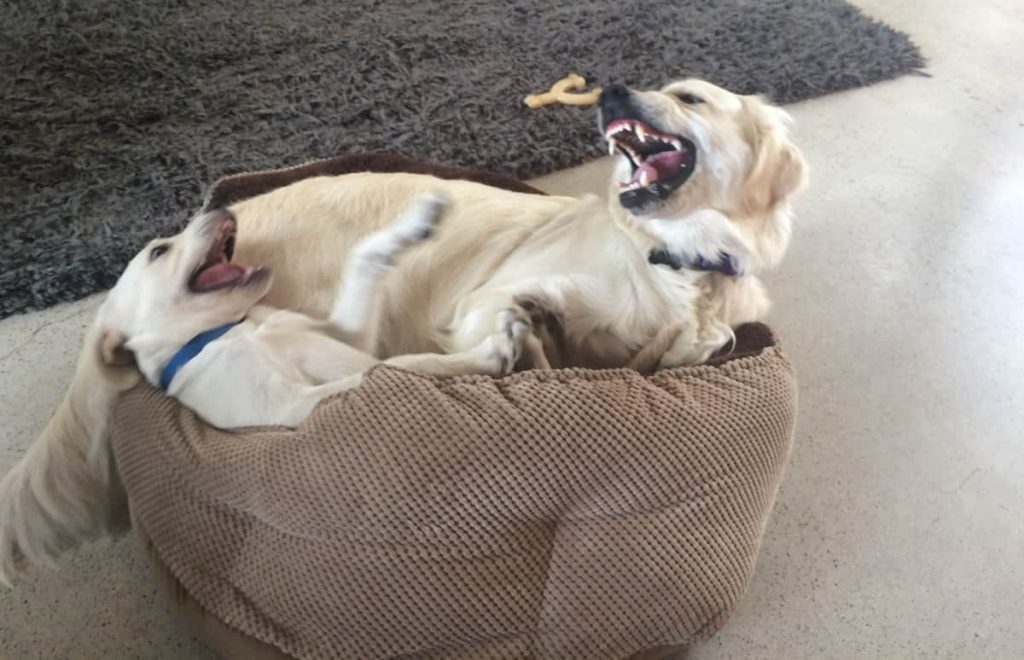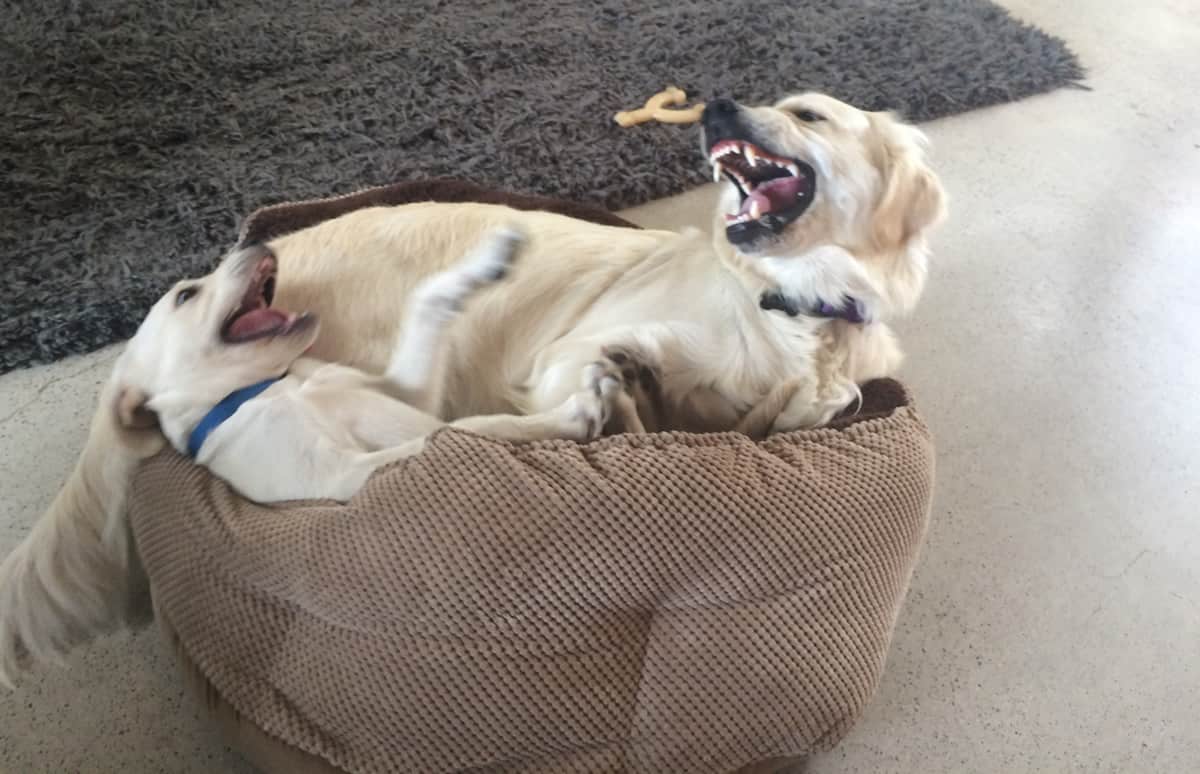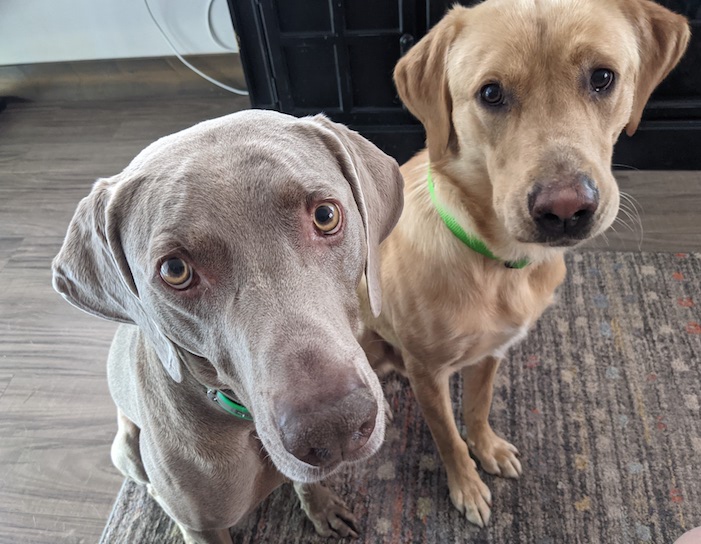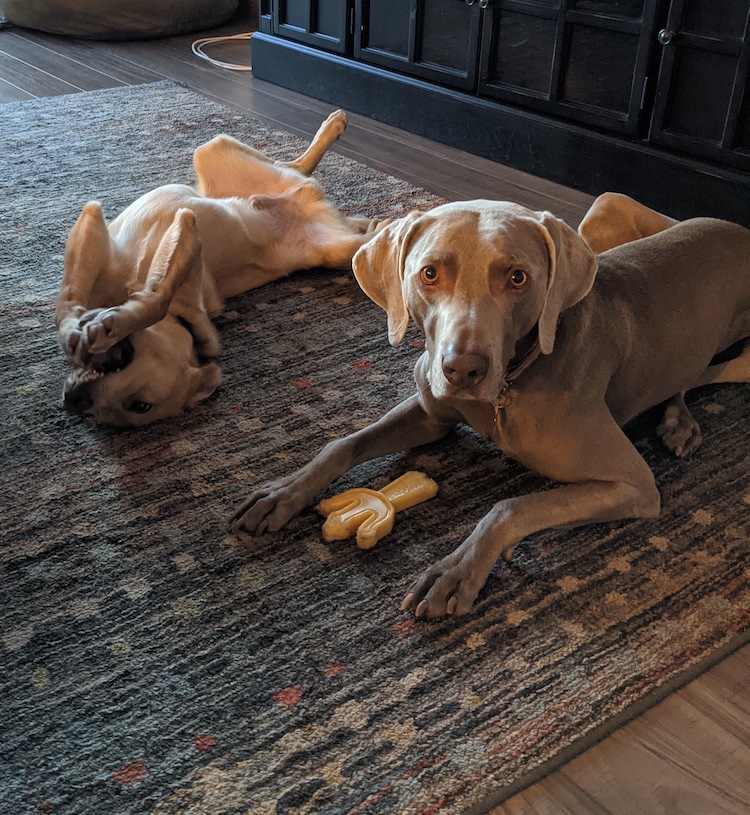I would love to stop my dogs from roughhousing indoors.
I have a weimaraner and a yellow Labrador. They are both very playful dogs who get bursts of energy several times per day!
We don’t have a yard, so I try my best to give my dogs the exercise they need.
We go for several leashed walks and runs each week. I give them some off-leash time on trails, and we compete in dog agility.
Still, I usually fail to provide my dogs with enough exercise on a weekly basis.
So they do a bit of “roughhousing” or wrestling in the house. Usually in the morning when they get up and again when they get the evening “zoomies.”
Should I let my two dogs roughhouse?
Roughhousing or play fighting indoors is normal dog behavior. It’s not a bad thing!
Play fighting is healthy for social dogs as long as all the dogs involved are having fun.
Wrestling and play biting helps dogs:
- bond with their dog friends
- improve their social skills
- help establish who is “in charge” in a safe way
- gets some energy out
Some people don’t mind if their dogs are chasing each other, body slamming each other into the furniture and growling loudly as they wrestle around for hours.
If this behavior is fine with you, then there’s no need to stop it as long as all the dogs involved are OK with it too.
That being said, some of us do not appreciate when our dogs roughhouse indoors!
If you’re reading this article, it’s probably because you’d like to put some limits on the amount of roughhousing your dogs do in the house!
What kind of playing is too rough for dogs in the house?

You get to decide when to stop your dogs from roughhousing indoors.
Here are some examples of what might be considered “roughhousing” or “play fighting” between dogs:
- wrestling each other
- play biting each other
- slamming their bodies into each other
- tugging and growling on toys
- racing and chasing around the furniture
- jumping on and off the furniture
- humping each other
- barking at each other
You get to decide what to allow from your dogs. (The dogs don’t get to decide).
Also see our article on dogs play fighting with people!
When to stop dogs from play fighting in the house
I typically tolerate 5-10 minutes of roughhousing indoors between my two dogs at at time.
I think it’s fair to let them play and wrestle a little bit in the house.
They’re just being dogs, after all. And like I said, we don’t have a yard for them to wrestle in.
Here are some reasons why someone might not want their dogs wrestling constantly in the house:
- The dogs are scratching your floors
- They’re jumping all over your furniture or knocking things over
- The dogs could break something or hurt someone
- It’s annoying you or stressing you out
- They’re preventing you from getting your work done
- They wake your baby or toddler up from naps
- Your dogs are constantly “amped up” and it doesn’t seem healthy for them
- Overall lack of control and structure
- Their intense play fighting leads to actual fights
- One dog seems to be bullying the other
When my two dogs are play fighting, their behavior starts to escalate to even crazier and louder behavior after about 5 minutes.
This is also when my older dog starts to get sick of the youngster and begins to disengage.
It’s important to learn to recognize when one dog has had enough playing.
Signs that one dog does not want to play or roughhouse
Most dogs will enjoy playing and roughhousing for a certain amount of time. But eventually, one dog might get tired of it.
At our house, my weimaraner stands up and shakes off when he has had enough playing. Then he takes a few steps away and sits down or pretends to sniff something.
My young Lab typically does not take this seriously and continues to try to play. He will mouth at my weim’s feet, slam his side into him or throw a paw over his shoulder to get a reaction.
I smile to myself and think “this is payback time” for my weim! He was the most obnoxious puppy back in the day. You can read about Remy’s puppy witching hour.
But when Remy starts to disengage from play, I know this is a good time to put one dog in their crate or encourage them both to stay on their dog beds.
If I don’t, then Remy will certainly let out a (very much justified) snarl! And the next level would be an actual nip or bite.
Signs a dog is no longer interested in playing:
- The dog shakes off and does not re-engage in play
- He walks away and sits down
- He leans into you or another person
- She pretends to be interested in sniffing something
- She picks up a bone or toy and intensely chews on it
- His tail is tucked and he tries to move away
- He might hop onto the couch to get away or go to his bed or crate
- The dog obsessively chugs water
- The dog is stiff and showing teeth
- Instead of “play biting” or mouthing the bites are getting more intense
How to control rough play with dogs in the house?
If you need to limit your dogs’ playing indoors, what can you do about it?
I don’t have the perfect answer, but I’m going to share my experience with these 8 reminders.
1. Decide how much roughhousing you will allow from your dogs
Your house. Your dogs. Your rules.
We each have to decide on our own rules for our own dogs. Then, it’s important to be consistent with them so they understand these rules.
At our house, about 5 minutes of the dogs wrestling on our living room rug twice a day is what I’m willing to tolerate.
Some people would probably think that’s very minimal and unfair to my dogs. Others might think two big dogs should not be allowed to wrestle in the house at all.
It doesn’t matter what anyone else thinks. Do what works for you and your dogs.
If you have a yard, you probably don’t mind if your dogs roughhouse and play outside all they want as long as they are both enjoying it.
If that’s the case, then you may want to have a cue like “Take it outside!” when your dogs start to roughhouse indoors. Then, open the door so they can do just that!
2. Have a cue to tell your dogs when play and roughhousing is over
When I want my dogs to stop playing, my cue to them is to stand up and say, “That’s enough!”
Then I reward them for doing any calm behavior such as standing and shaking off, sitting, calmly chewing on a toy or getting a drink of water.
You’ll need to practice your cue with your dogs and then follow through by interrupting their play and rewarding them for calm behavior. For example, praise them or give a treat if they stop and sit.
Until your dogs understand this cue, you might have to physically walk over and separate them and lure them with a treat to sit or go to their dog bed. Just stay consistent and reward them for anything other than roughhousing.
3. Teach your dog to “go to his bed” or “place”
I randomly tell my dogs “Place!” throughout the day, even when they are not roughhousing. Then I reward them for lying down on their dog beds, which are in the living room where they like to wrestle.
Once they’re on their beds, I tell them to stay. My older dog will stay there for as long as I need, and I’m working on increasing the time with my younger dog.
It helps to work with each dog separately in short training sessions. Remember to have a release word such as “OK” or “break” so the dogs learn to stay until released.
Otherwise, it’s a guessing game for them trying to test how long they should stay.
For more info, see our article on how to teach a dog to go to his bed.
4. Use crates and gates to manage dog roughhousing indoors
Crates are very helpful, of course. I keep one large dog crate in our living room so I always have the option of putting one dog in the crate. I do this several times per day.
Both my dogs are crate trained and they know they get a treat or Kong or bully stick in their crate.
You could set up one crate for each dog if that works better for you. In our case, as long as I crate one dog, then the other one always calms down too.
I try not to use the crate as a punishment (even if I’m very annoyed). I’ll say “Kennel!” in a positive voice and then praise the dog. I usually give the dog a small treat as well.
Pet gates can work just as well, especially if your dogs aren’t kennel trained.
When we lived in a small apartment, where space was limited, it made more sense to set up a couple of pet gates vs. two large dog crates.
5. Provide your dogs with outdoor exercise and play
Providing your dogs with enough exercise does not magically stop them from roughhousing indoors. Many young dogs will want to play and wrestle regardless.
However, when dogs have less pent-up energy they can generally be managed much easier. And they’re probably going to do a lot less roughhousing.
Think about what kind of exercise helps your dogs decompress.
For my dogs, going for an off-leash hike or run in nature is ideal. If the hike is long enough it helps them relax. Running off leash allows them to move freely, sniff and just be dogs.
Check out Cog Dog Radio’s podcast on “decompression walks” for why this kind of exercise is best for most dogs.
The next best thing for my dogs is to go for a hike on a leash. And the third best option is to go for a leashed walk or run on a quiet country road or even right in our own neighborhood.
Activities like playing tug or playing fetch over and over are not ideal for my dogs because it puts them in a stressed-out, hyped up state of mind.
Take a look at your schedule and do your best to get a long hike or walk in with your dogs every day if you can. Or, at least a few times per week.
How long does this walk need to be? It depends on the dog. For my dogs, at least an hour per day would be ideal.
They definitely are not getting this much exercise right now. My goal is to provide them with a run or walk at least four times per week. The more exercise I can get in for them, the better.
6. Give Kongs or other chews to stop dogs from roughhousing indoors
A lot of dogs will fight over things like Kongs or bully sticks, so you may need to separate them before giving them high value items.
Chewing on a Kong, bully stick or Nylabone gives my dogs something constructive to do and helps to drain their energy.
When my dogs are chewing on toys, they are not roughhousing! So, I try to provide them with something to chew on every day.
That being said, for my particular dogs I need to keep soft toys like stuffed animals, tug toys and squeaky toys picked up because these toys make them hyper AND they try to eat them.
I only bring out these “exciting” toys out when I’m OK with a little roughhousing.
7. Reward the behavior you like!
Remember to praise and reward your dogs for calm behavior!
I keep a small dish of treats on my countertop and try to make a point to drop my dogs each a small treat when I catch them lying calmly on their dog beds.
8. Dogs do need to play!
If you have a social dog who loves to roughhouse and play with others, try to provide that option for him once a week.
Take him to a dog park if he has appropriate dog-park manners or take him to the right dog daycare every now and then to play!
My dog Remy plays well at dog daycare, so I usually have him spend the day there once a week on Mondays.
What ideas do YOU have to stop dogs from roughhousing indoors?
So those are my tips for managing the roughhousing between multiple dogs. The more dogs you have, the more challenging this is going to be!
Please share your tips for stopping a dog from roughhousing indoors in the comments below!


